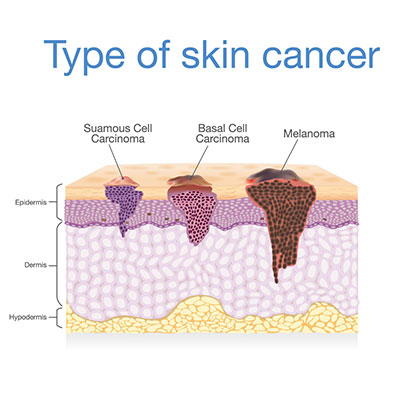
Skin cancer


Overview
Skin cancer is the rapid growth of abnormal skin cells. Most common cause of skin cancer is over exposure to ultraviolet (UV) light radiation of the sun, but not in every case.
The three main types of skin cancer are the following:
- Basal Cell Carcinoma: the most common type of skin cancer in the world. This type of cancer started at the basal cells. It usually happens at the areas that are exposed to the UV light.
- Squamous Cell Carcinoma: the type of cancer that started at the squamous cells. The common cause is the over exposure to UV light.
- Melanoma – the most invasive type of skin cancer. It starts at the melanocytes (cells that produce melanin). This type of skin cancer could spread to other organs of the body if left untreated.
Avoiding or reducing the over exposure to the UV light could help reduce the risk in developing skin cancer, sunscreen could also help protect the skin. Skin cancer is most likely to be treated when diagnosed at an early stage.
Symptoms
Signs and symptoms of skin cancer are as follows:
- Basal Cell Carcinoma mostly occur at the areas of the skin where it is exposed to the UV lights such as head, neck, arms, hands, and legs.
Basal cell carcinoma signs include:- Shiny pearl-like or waxy bump.
- Skin colored or brown scar-like lesion.
- White, waxy, scar-like lesion without clear border.
- Bleeding or scabbing sores that do not heal.
- Squamous Cell Carcinoma mostly seen in sun-exposure areas such as face, ears, and hands. Dark-skin people are more likely to be affected by squamous cell carcinoma even those areas are not over exposed to UV light.
Squamous cell carcinoma signs include:- Firm, red nodule.
- Flat, scaly lesion.
- Open sores
- Thickened or wart – like skin
- Melanoma develops at any areas on the body, it can occur at areas that is not commonly exposed to the UV light.
Melanoma signs include:- Brownish spot with darker patch.
- Lesion that is painful, itchy, or burning sensation.
- Changes at a mole, in color, in size, or bleeding.
If you notice any changes to the skin, and any signs and symptoms, please make an appointment with your doctor.
Causes
Skin cancer occurs when there is a change of DNA in the skin cells. The most common cause of skin cancer is over exposure to the UV light of the sun, and/or tanning beds that damages the DNA of the skin cells which causes abnormal growth of cells that could form into a mass of cancer cells. Exposure to toxic substances or having factors weakening the immune system, could also contribute to the risk.
Risk factors
Factors that may increase skin cancer risk includes:
- Family history – It is highly possible to develop skin cancer if there is a history of cancer from one of your parents or a sibling.
- Overexposure to UV light – people who have over exposure to the UV light of the sun (working or playing) may develop skin cancer, more likely if the person doesn’t use or protected by sunscreen. Excessive usage of tanning beds may also put the person at risk.
- History of sunburn – person who have history of easily sunburnt skin and blisters from sunburn increases the risk of developing skin cancer.
- Tropical or High-altitude climate – people who lived in higher ambient temperature and those who are exposed to UV light are more likely to develop skin cancer.
- Skin color – anyone can get cancer regardless of the skin color. People who have fair skin could provide minimal protection from UV light and is more likely to be at risk of skin cancer.
- Moles – anyone who have many moles or abnormal moles named dysplastic nevi have an increased risk to develop skin cancer. Irregular shaped-moles are higher risk than normal moles, and should be assessed by the physician especially if the mole is bleeding.
- Weak immune system – people who have a weak immune system or are taking immunosuppressant drugs could be at risk.























